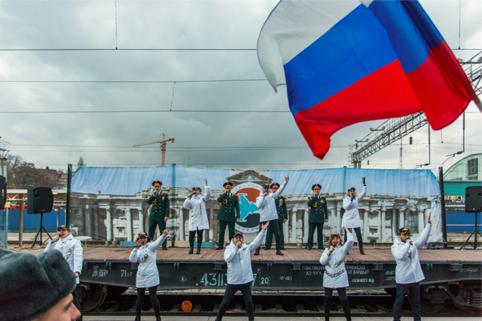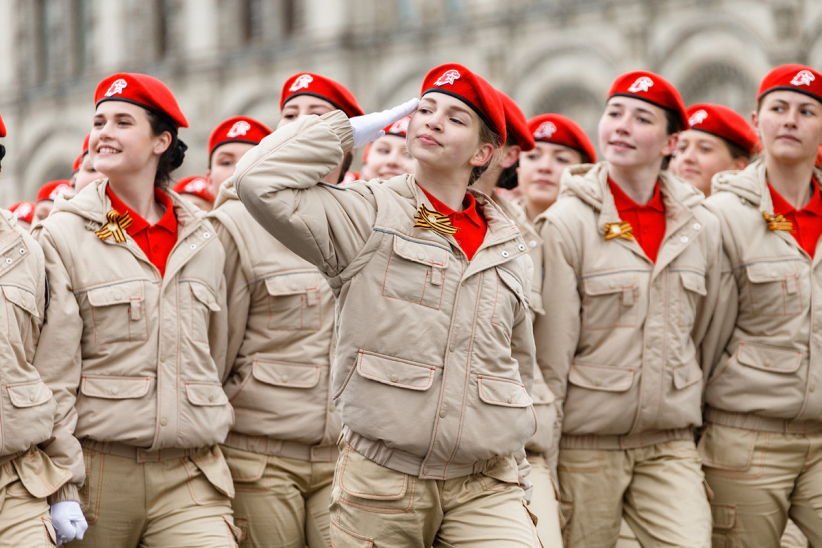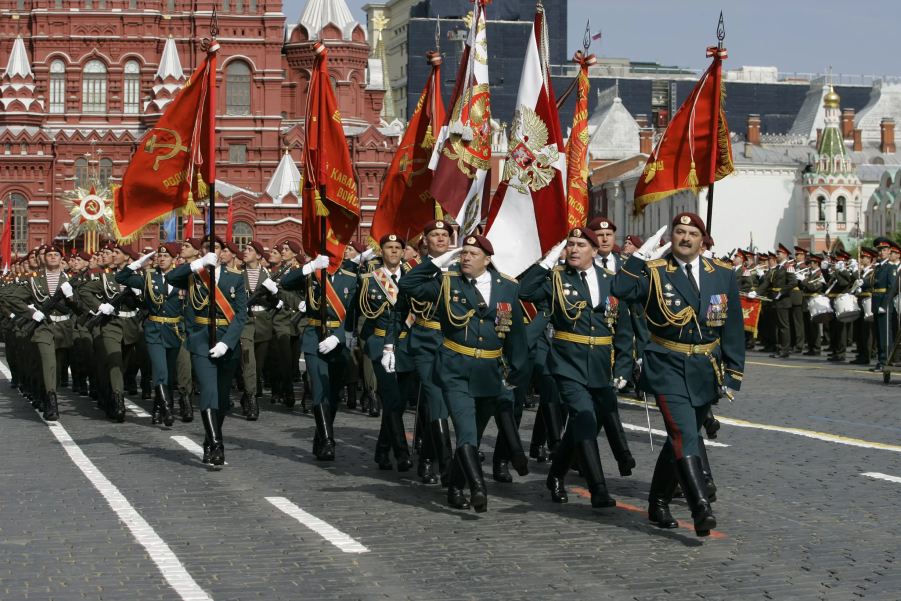"Na rodina" - "For the Fatherland": the new place of the officer in Russian society
The Red Army, standard-bearer of the CPSU. Military parade on Red Square on the occasion of Victory Day. Source: Yandex Images
This article highlights the rehabilitation of the image of the officer in Russian society since Vladimir Putin came to power in 1999. Mademoiselle Marquant thus shows how Russia has combined the glorification of military achievements, past and present, with the popularization of military careers among young people, in order to strengthen the patriotic feeling of the entire people while meeting the mass need of its army.
Since Vladimir Putin came to power in 1999, the government has tended to rehabilitate the prestige of its army. Indeed, if the Soviet officers were erected as heroes, victorious over Nazi Germany, the fall of the USSR has tarnished the image of the army. In a context of economic and social crisis leading to a reduction in defence spending, military personnel were living in dramatic conditions. In 1997, the researcher Elisabeth Sieca-Kozlowski testified: " The Russian army is a malnourished, poorly housed, disoriented, trampled, abandoned army, whose primary objective is no longer to maintain its combat capability but tosubsist, by all means ".1. Once adored, the officer has lost its prestige and has become a social, economic and identity issue. How has the Russian government contributed to improving the image of the officer and of the army in general since the end of the USSR?
Giving a new political role to officers
In the course of its history, the Russian army has rarely played an important political role. This was the case during the Soviet period. Following the Revolution of 1917, a separation took place between the Tsar's followers and those who joined the Red Army. The missions and objectives of the Red Army officers were to protect and promote the interests of the Party-State, to be loyal and obedient to the Communist Party of the Soviet Union (CPSU), to avoid political interference, and not to use the men under their command for private purposes.2. Thus, the officer belonged to a body that exceeded his own individuality. However, the Bolsheviks, distrustful of the loyalty of officers to the Communist Party-state, introduced control mechanisms. On the one hand, the Main Political Directorate, an intra-military organization of political officers, ensured the ideological purity and political reliability of the armed forces. On the other hand, the CPSU used regular and military intelligence to ensure the reliability of the armed forces. Political advisers were also attached to army units to ensure the loyalty of officers and to make political propaganda to the troops. These commissioners thus provided a double check: orders given by a military officer had to be approved and countersigned by a political commissioner.3.
Nevertheless, from the late 1980s onwards, the officer corps played an increasingly important political role. Military political activism", i.e. political participation and involvement, should be distinguished from "political influence".4s ability to influence policy makers. The increased presence of officers in the power elite is believed to be due to Russia's opening up to a market economy in the early 1990s.5. The former members of the Soviet special services, especially those of the Committee for State Security (KGB), were the only ones authorized by the Soviet government to study and visit the West (economics, politics, language, law). These men therefore seemed the most qualified to help Russia insert itself into the new world emerging from the rubble of the USSR.
Thus, the militarisation of power would result in the over-representation of officers in its upper echelons, allowing the armed forces to have a more important position in Russia. The most striking examples are the roles played by the Minister of Defence Sergei Choigou, or General Valery Gerasimov, Chief of Staff, who in particular supervised operations in the Crimea and launched the Russian operation in Syria in September 2015. Nevertheless, more than a 'militarisation' of the government, we could above all speak of an ' FSB-ization .6 or a " special force-ization " of which Vladimir Putin, from the Federal Security Service of the Russian Federation (FSB), would be the first representative.
Federating officers and the population through the glorious past
During the Great Patriotic War (1941-1945), Soviet leaders chose to bring the army and the population together as a united whole, ready for battle. This task became a reminder of Russia's glorious past: the heroic experience of defending freedom. Special attention was paid to the liberation of Russia from "foreign interventionists": Alexander Nevsky against the Teutonic Knights in 1240 and 1242, Dmitri Donskoy against the Tatars in 1380, Dmitri Pojarski against the Lithuanian-Polish interventionists in 1630, and Soviet officers against Nazi Germany. Since Vladimir Putin came to power, the Great Patriotic War has become a new stage in the development of traditions of military heroism. The exaltation of Russia's heroic past has made it possible to unite civil and military forces around common values, as demonstrated by the celebrations of Defender of the Fatherland Day on 23 February and Victory Day on 9 May.
The Day of the Defender of the Fatherland has existed since 1919, but took its present name from a decision by Vladimir Putin to declare it a public holiday in Russia in 2002. Officially, the holiday celebrates those who serve or served the Russian armed forces (men and women, military and civilians), while parades and processions honour veterans. Victory Day is celebrated on 9 May and commemorates the signing in Berlin of the act of surrender of Nazi Germany with the Allied troops (at 11 p.m. on 8 May, French time, but at 1 a.m. on 9 May, Moscow time). This day has been a public holiday since 1965; however, in the 1990s, its celebration fell into disuse. After Vladimir Putin came to power, national holidays and commemorations once again became a source of national pride. Victory Day has gradually become a celebration in which popular culture plays a central role. In Moscow, a large military parade takes place and the population wears the St. George's ribbon.7 to celebrate the event. The 60th and 70th anniversaries of Victory Day in Russia (in 2005 and 2015) were thus the largest popular celebrations organized since the collapse of the Soviet Union.
These two celebrations illustrate the return of patriotism with military overtones. Although other festivals exist, such as the Day of National Unity (4 November) and the Day of the Russian Federation (12 June), which is also regarded as a national holiday, Victory Day remains the festival that unites the population. It is celebrated by the whole of Russian society. For example, in a survey conducted by the independent research centre Levada8 carried out in December 2018, to the question " what makes you proud of past events? "86% of respondents answered " victory in the Great Patriotic War ". Similarly, to the question "what is the first thing that comes to mind when you think of your people? "53% said " our past and our history ," compared to 37% in 1994 and 46% in 2016; 17% said " our military power ," compared to 5% in 1994.
The success of military operations is an essential component in restoring the prestige of the officer profession, and of the military in general. That is why the government is communicating extensively about the success of operations in Syria. For example, it recently reused a Soviet-era method of disseminating military successes and promoting patriotism: a travelling train exhibit. Between June 1943 and October 1948, such an exhibition carried Nazi war trophies captured by the Soviet Union. Similarly, in 2019, a train consisting of twenty cars travelled a distance of 28,500 kilometres. It stopped at sixty stations where captured weapons and equipment, photo galleries glorifying the Russian army and even a souvenir shop were displayed. The exhibition was also accompanied by singing and dancing, and by Russian soldiers who had returned from Syria to tell of their exploits.
Making an officer's career more attractive to young people
In order to make a military career more attractive, the first step was to develop patriotism in Russian society, especially among young people. In his Millennium Manifesto9 announcing the programme for his candidacy in the 2000 presidential election, Vladimir Putin evoked the idea of "values" to be defended, three of which are of prime importance:patriotism (patriotizm), power(derjavnost) and a sense of statehood(gosudarstvennitchestvo). According to V. Putin defines patriotism as "a sense of pride in one's homeland, its history and achievements. It is the aspiration to make one's country more beautiful, richer, stronger, happier ".10.
Since the election of V. Putin in 2000, four programmes of " Patriotic Education of the Citizens of the Russian Federation " have been carried out in order to inculcate patriotism in the youth. Patriotism is defined in these texts as " love of the Fatherland, devotion to the Fatherland, willingness to serve its interests and preparation for its defence, including self-sacrifice ".11. Patriotic education must thus make it possible to give " a new impulse to the spiritual rebirth of the people of Russia ", to " maintain social stability, to restore the national economy, to strengthen the defensive capacity of the country ".12.
In fact, young people more often define patriotism as " love for one's homeland " and see it little as " willingness to defend one's country in situations of emergency or extreme danger ". For young people, patriotism means first of all having a good knowledge of Russian history, traditions and culture, or feeling respect for one's country, but does not imply commitment or concrete actions.13. However, young Russians seem fascinated by public manifestations of patriotism, including mass actions, electoral activities and historical commemorations. Official educational institutions and the mass media therefore play a key role in the way young people represent their country and their connection to it. The Government is aware of the declining sensitivity of young people to patriotism and their appetite for mass events. In April 2019, it launched the Pobeda (Victory) channel for young people.14. This channel broadcasts Soviet films, the latest big productions praising the heroism of the army (such as the film Tanks for Stalin by Kim Druzhinin, released in 2019), documentaries on the Great Patriotic War and broadcasts the May 9 parade. The channel was created in view of the 75th anniversary of the end of the Great Patriotic War in 2020 and is, according to the director general of Perviy Kanal (1st channel), Konstantin Ernst, "a tribute to our elders and witnesses, which we want to pass on to our descendants ".
The military domain is only one aspect of patriotism in which the paramilitary associations supported by the government are major players. One of the most recent is Yunarmia (The Young Army), created on 29 July 2016 by decree of the Russian Ministry of Justice. Patriotic education is at the heart of its objectives, since its charter defines as a priority " the preservation and promotion of patriotic values ". Yunarmia has 272,000 members aged between 8 and 17. Its activities are divided into four categories: spiritual and moral education, intellectual development, physical and sports education, and social actions. This association is reminiscent of the Pioneers and the Komsomol, Soviet youth organizations from 1918 to 1991, or the DOSAAF (Voluntary Society for Assistance to the Air Force, the Army and the Fleet), founded in 1927 by the Ministry of Defence. Its 2010 charter15 Recalls the need to offer patriotic education to a wider section of society and to be a source of mobilisation.
More generally, paramilitary associations seem to meet three objectives:
- To develop civic engagement and a sense of community:
" Only by resorting to the notion of patriotism can it be brought back into the collective. Patriotism presupposes the self-denial of individuals towards the national community as a whole .16. This civic reengagement or the " re-politicization of societies "...17 is therefore not just about military integration. It would be similar to the operational superiority factor "moral force" in the French Army, which is based in particular on the " development of the sense and legitimacy of commitment " and " individual training, especially in ethics and deontology ".18.
- Mobilizing and rallying against an external threat :
The theme of the threat, whether internal or external, is important even if it is not always clearly defined. Young people are directly concerned by these threats. On the one hand, because it is presented by the government as the bulwark that would defend Russia from abroad, and on the other hand, because the youth should be protected from foreign influences, especially from decadent progressive ideas.19. The Russian Ministry of the Interior is actively combating " the manipulation of children's consciences through social networks " and plans to send "problem" children to patriotic camps.20.
- Favouring "prospective integration".21 :
Younarmia makes it possible to transmit military values to young people and to provide them with preliminary military training that would make conscription, reduced to one year, more effective since the young people thus trained would already have learned the first rudiments of combat. One of the objectives also seems to be to make military service and careers more attractive.22. Indeed, very few conscripts do their military service, since with the right means, it is possible to avoid it. Many conscripts therefore come from disadvantaged social strata. Younarmia therefore encourages its recruits to embark on a military career. In addition, members who wish to become officers can put themselves forward by distinguishing themselves in the association's competitions: weapon assembly, shooting accuracy, physical endurance. In addition, twenty universities across the country would award members of the association additional credits based on their achievements. However, Younarmia, despite its mass communication, has so far only 1% of the population in its ranks.
In conclusion, Vladimir Putin wished as soon as he came to power to restore the image of an army tarnished by the economic and social crisis following the fall of the USSR. To this end, he strengthened the power of the army by appointing officers to key government posts. He also brought together the military and the civilian world around military exploits, past and present, notably through mass ceremonies. Finally, in order to attract more and more young people to the military career, it has promoted the development of activities in paramilitary associations that offer significant advantages for the pursuit of secondary and higher education. However, the growing employment of contract workers and private companies such as the Wagner group have lasting social and identity-related consequences for the Russian army, reinforcing the need to develop patriotic sentiment among the entire population.
--------------------------------------------
1 Elisabeth SIECA-KOZLOWSKI: The Russian army: survival strategies and modalities of individual and collective action in situations of "chaos", Cultures & Conflicts, winter 1996-spring 1997. Available online at: http: //journals.openedition.org/conflits/2170.
2 Zoltan BARANY: Civil-Military Relations and Institutional decay: explaining Russian Military politics, Europe-Asia studies, Vol. 60, No. 4, June 2008, pp. 581-604.
3 Zoltan BARANY, op. cit .
4 Zoltan BARANY, op. cit.
5 Cyrille GLOAGUEN: Armed forces and politics: a long Russian passion, Herodotus, Vol. No. 116, No. 1, 2005, pp. 111-137.
6 Thomas GOMART: Russian Civil-Military Relations: Putin's Legacy, Carnegy Endowment, 2008, pp. 56-57.
7 This ribbon refers to the Soviet medal " For Victory over Germany in the Great Patriotic War 1941-1945 " and has become a symbol of patriotism.
8 Levada Centre: National Identity and Pride, 25/01/2019. Available online at: https://www.levada.ru/en/2019/01/25/national-identity-and-pride/
9 Vladimir V. POUTINE: La Russie à l'aube du millénaire / " Rossia na rubeze tysaceletia ", Nezavisimaja gazeta, 30 December 1999, quoted by Françoise DAUCÉ, Myriam DÉSERT, Marlène LARUELLE, Anne LE HUÉROU, Kathy Jeanne ROUSSELET in Les usages pratiques du patriotisme en Russie. Research Questions, 2010, p. 9.
10 Vladimir V. PUTIN, op.cit.
11 Government of the Russian Federation, Concept of Patriotic Education of Citizens of the Russian Federation, 21 May 2003. Available online: http: //www.fadm.gov.ru/ projects/280/525/MAIN/. Quoted by Françoise DAUCÉ, Myriam DÉSERT, Marlène LARUELLE, Anne LE HUÉROU, Kathy Jeanne ROUSSELET, Les usages pratiques du patriotisme en Russie. Research Questions, 2010, p. 11.
12 Government of the Russian Federation, Order of 10 February 2001, " On the State Programme Patriotic Education of Citizens of the Russian Federation for 2001-2005 ", Available online: http: //www.llr.ru/razdel3.php?id_r3=73.
13 Daria OMELCHENKO, Svetlana MAXIMOVA, Oksana NOYANZINA, Natalia GONCHAROVA & Galina AVDEEVA: National Identity and Patriotism among Russian Youth: Representations, Feelings and Actions, Asian Social Science, Vol. 11, No. 6, February 2015.
14 "" Pobeda" started today - the new channel of the first channel's "Digital Telefamily" ", Perviy Kanal, 9 April 2019. Available online at: https: //www.1tv.ru/news/2019-04-09/363323-segodnya_nachala_veschanie_pobeda_novyy_kanal_tsifrovogo_telesemeystva_pervogo.
15 http.www.dosaaf.ru/home/ustav-dosaaf.
16 Françoise DAUCÉ: L'État, l' armée et le citoyen en Russie post-soviétique, Paris, l'Harmattan, 2001, p. 255.
17 Pierre MOUGEL: La militarisation de la jeunesse dans l'espace post-soviétique ⅔, BRENNUS 4.0, February 2019.
18 État-major de l'Armée de Terre, Action terrestre future, 2016.
19 Iskender YSAVEEV: Militarization of the National idea: the new interpretation of patriotism by the Russian Authorities, CSS ETHZ, Russian Anatycal Digest, No. 207, 26 September 2017, pp. 12-14.
20 " The Ministry of the Interior has intensified the fight against the manipulation of the consciousness of adolescents through social networks " / " MVD aktivizirovalo bor'bou c manipoulirovaniem soznaniem podrostkov tcherez sotseti ", Tass, https://tass.ru/obschestvo/6209292, 12 March 2019.
21 Pierre MOUGEL, op.cit.
22 ' The Ministry of Defence will call 1 million children to Yunarmia ', Gorod 812, 17 April 2019, http://gorod-812.ru/minoboronyi-prizovet-v-yunarmiyu-million-detey/?fbclid=IwAR2jurSPDnPEAh4NmfLUpcFo0FrPi61eQi6ksRxhg_FxBChCCnUbiLo2Trw.








